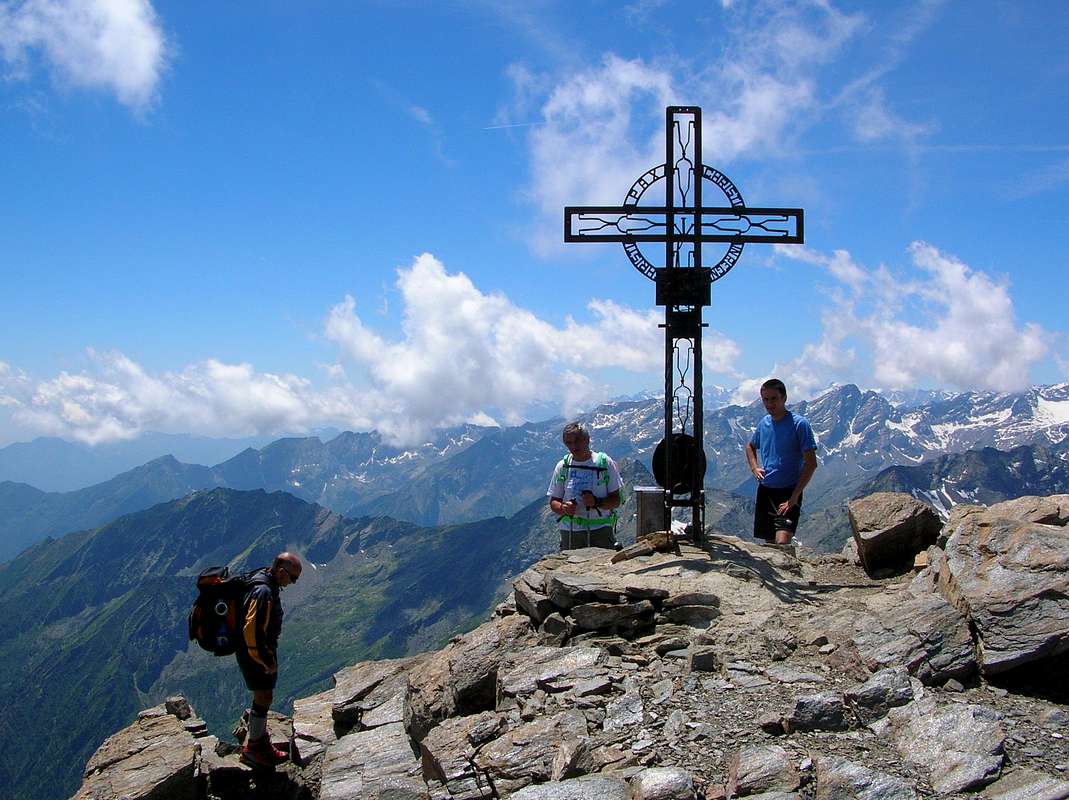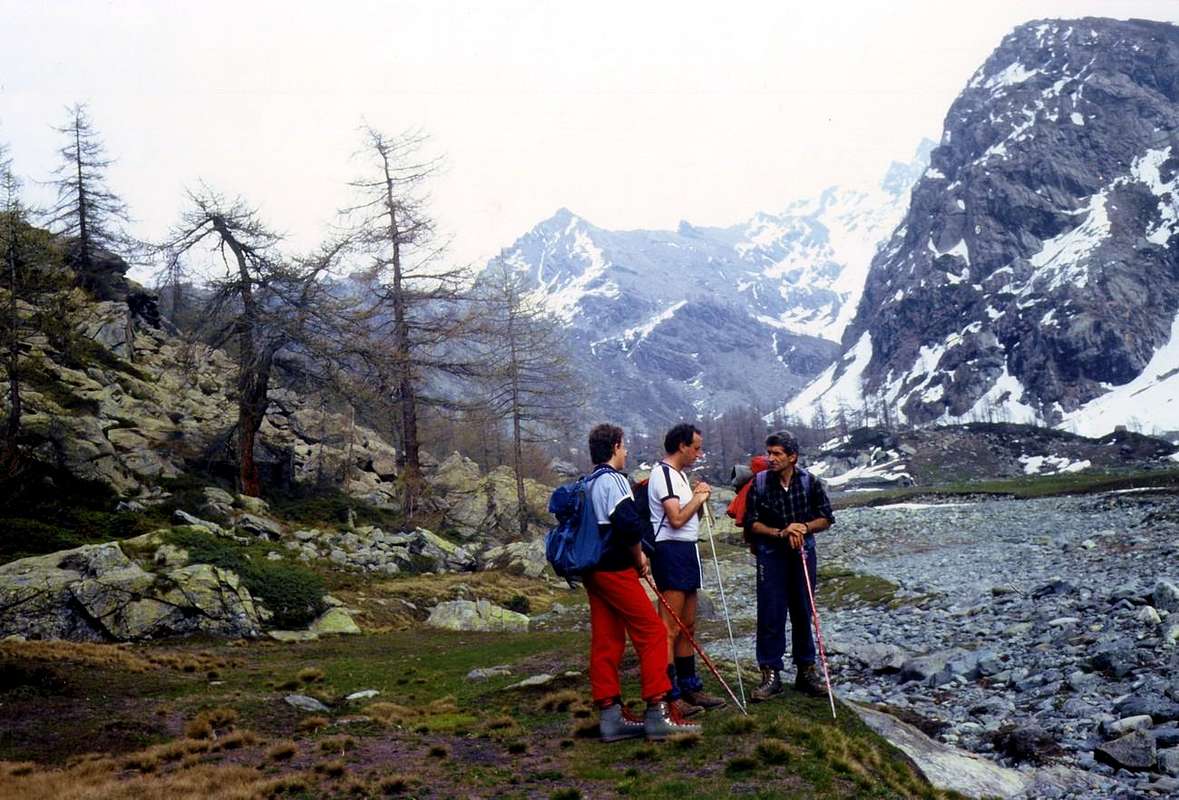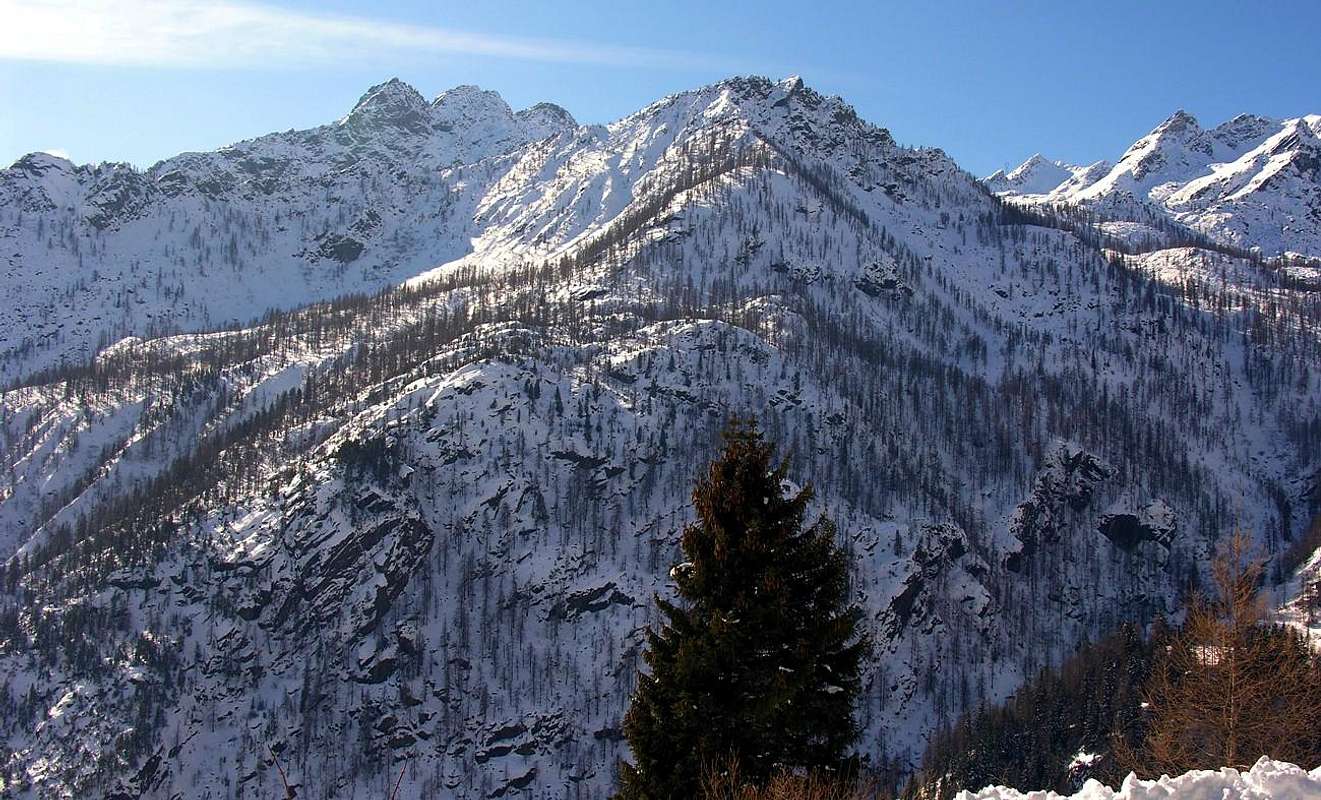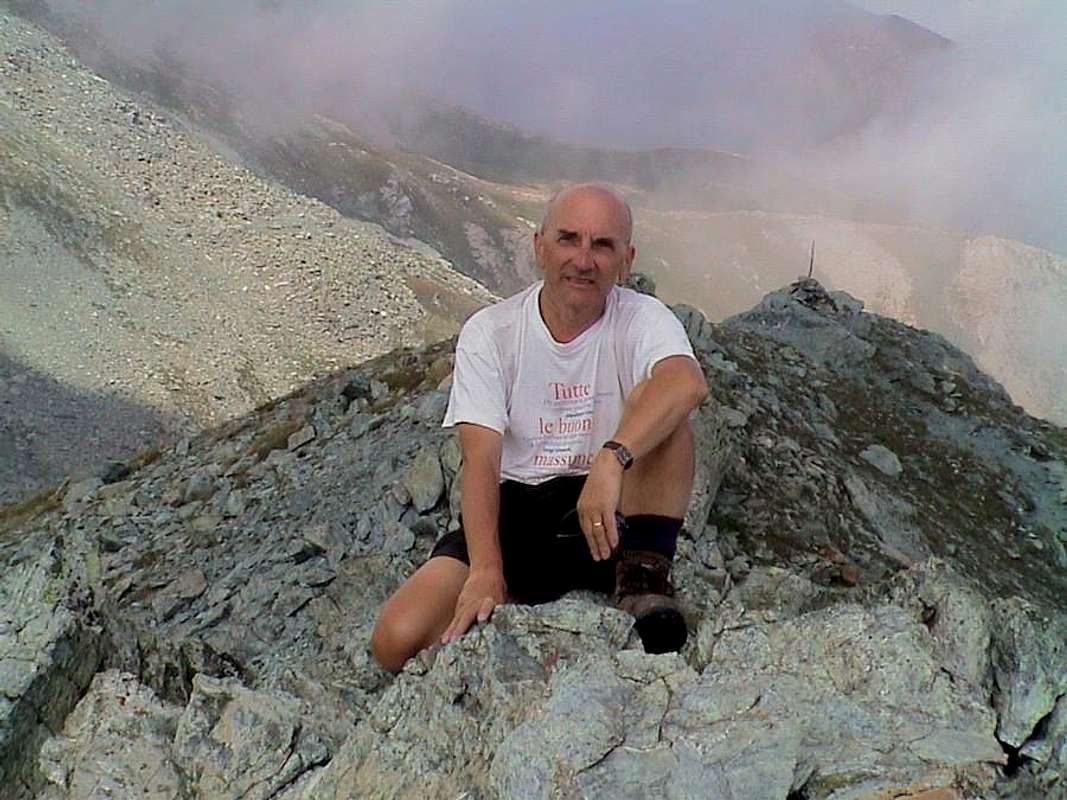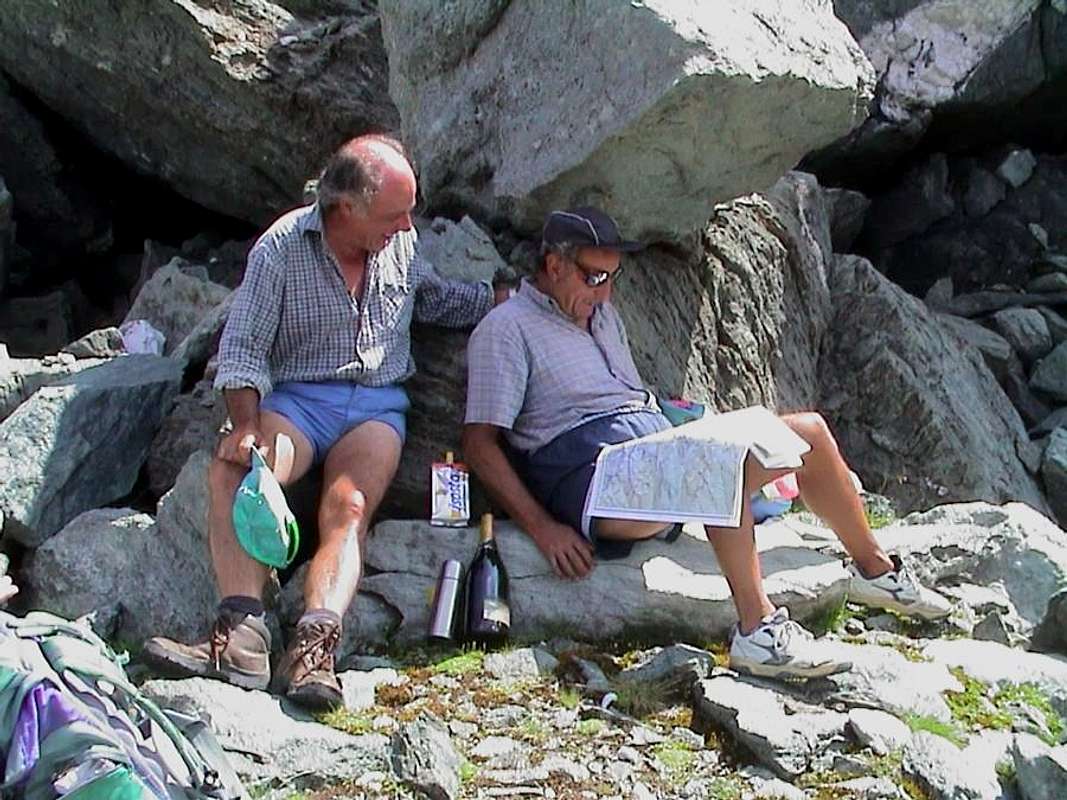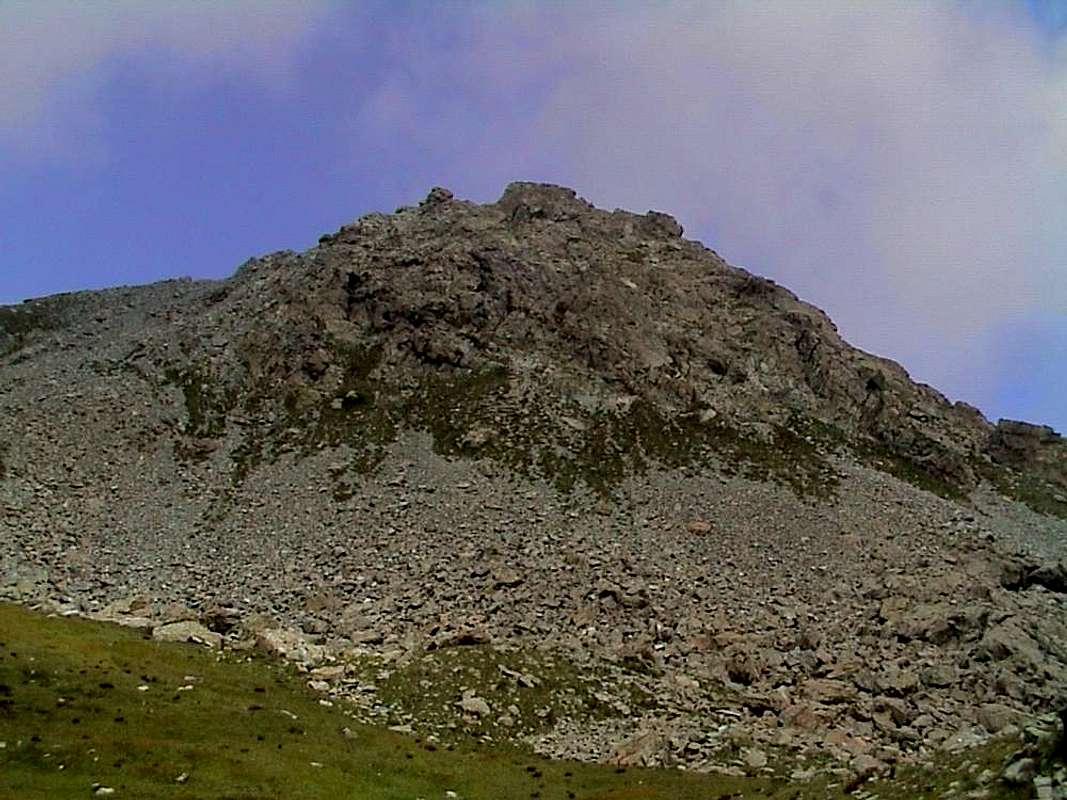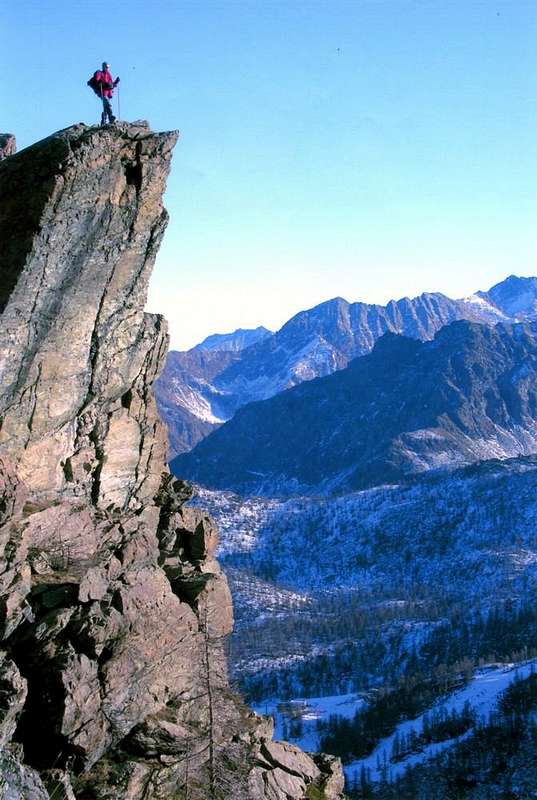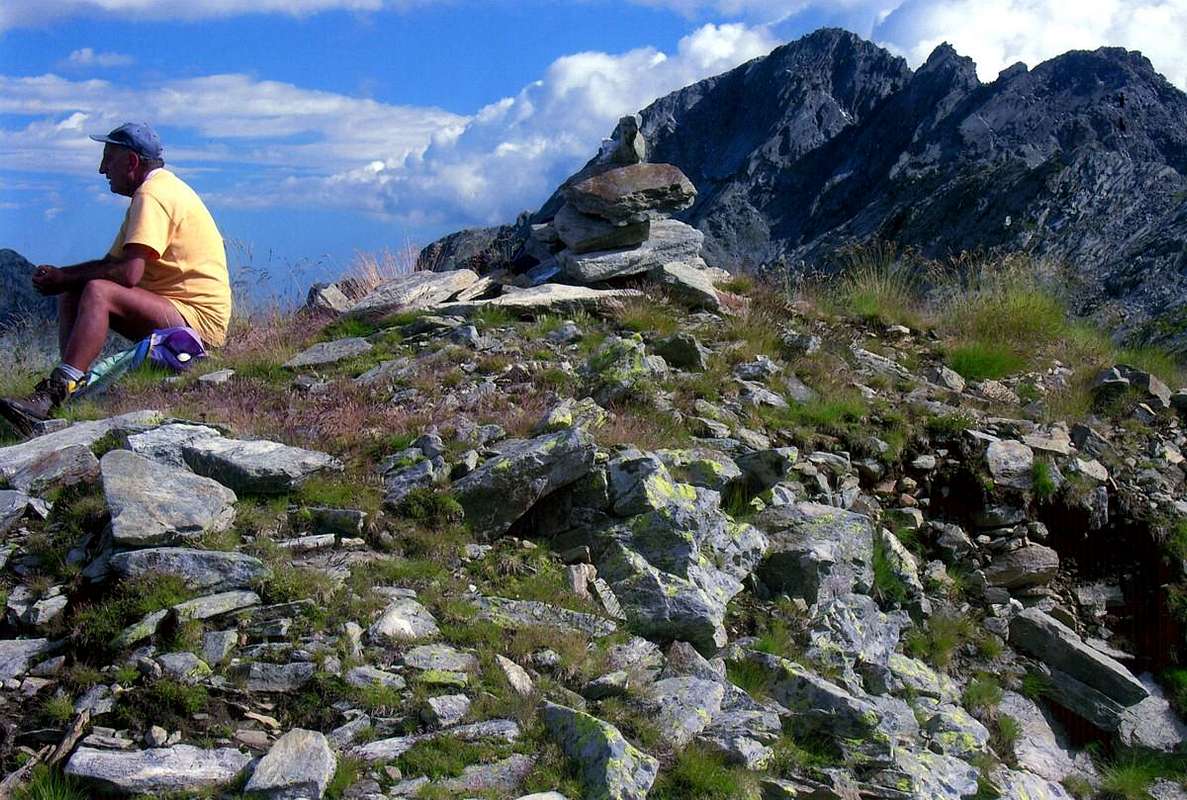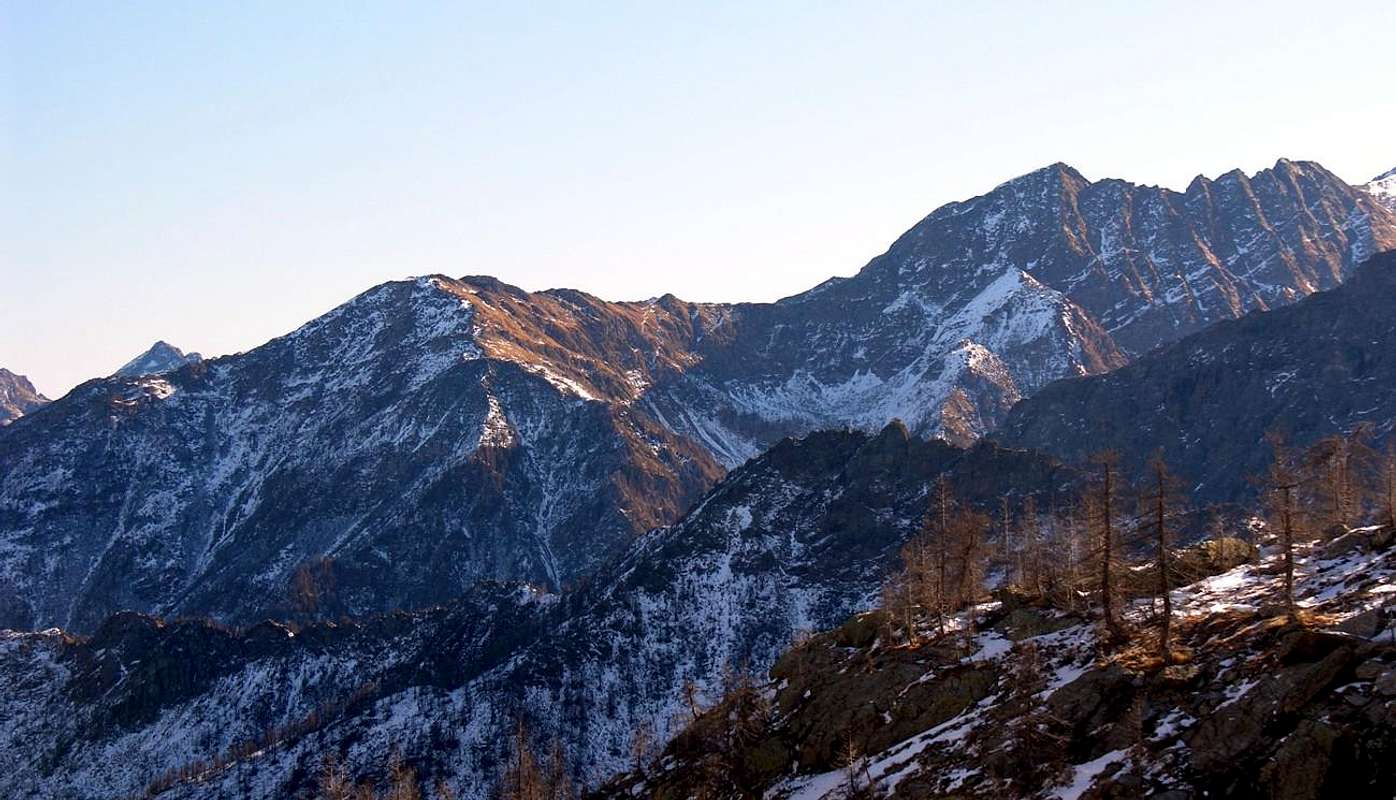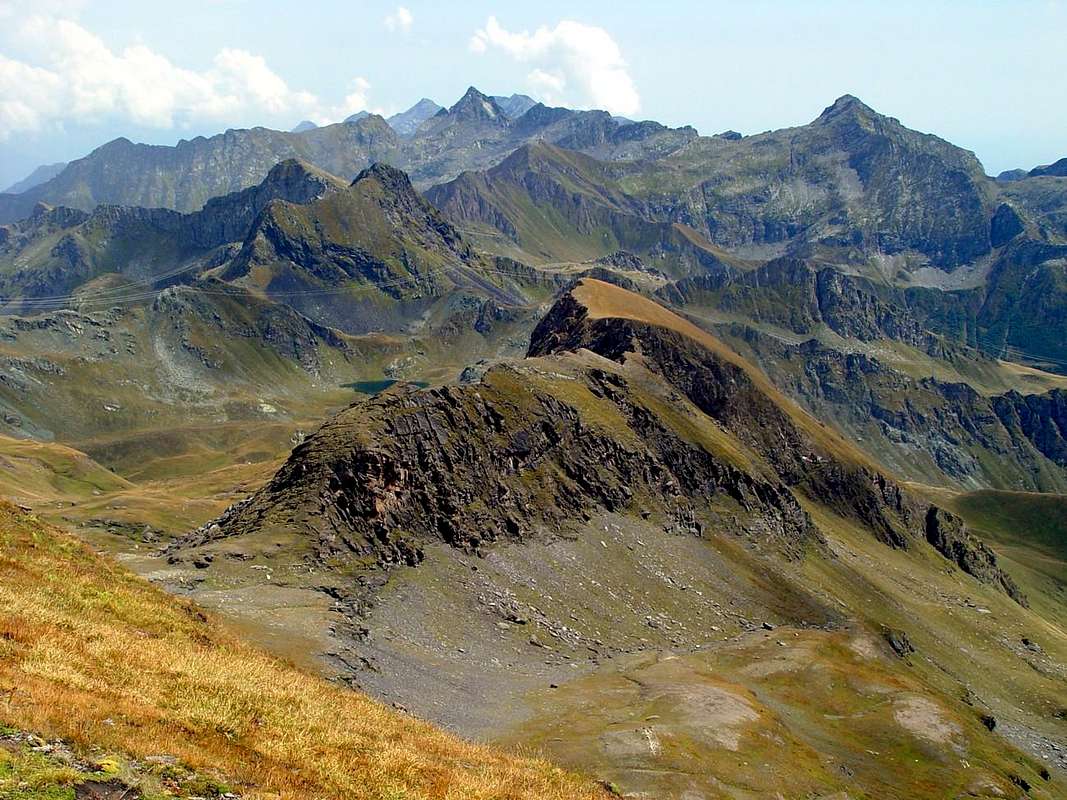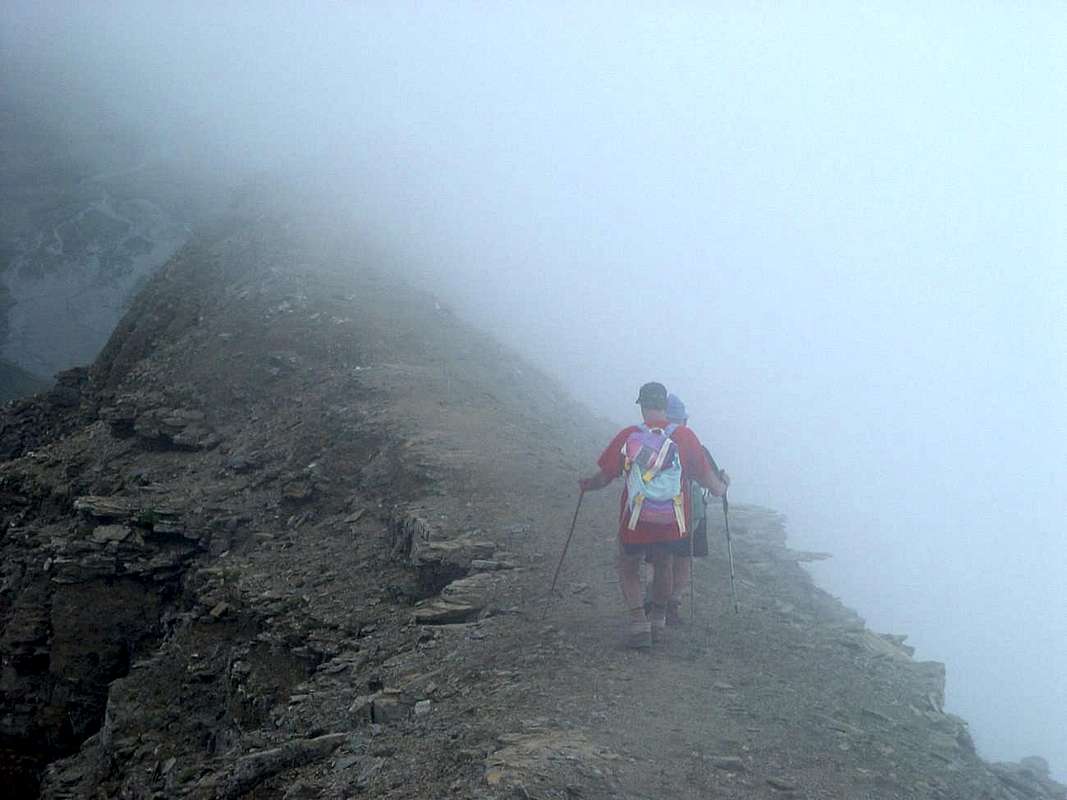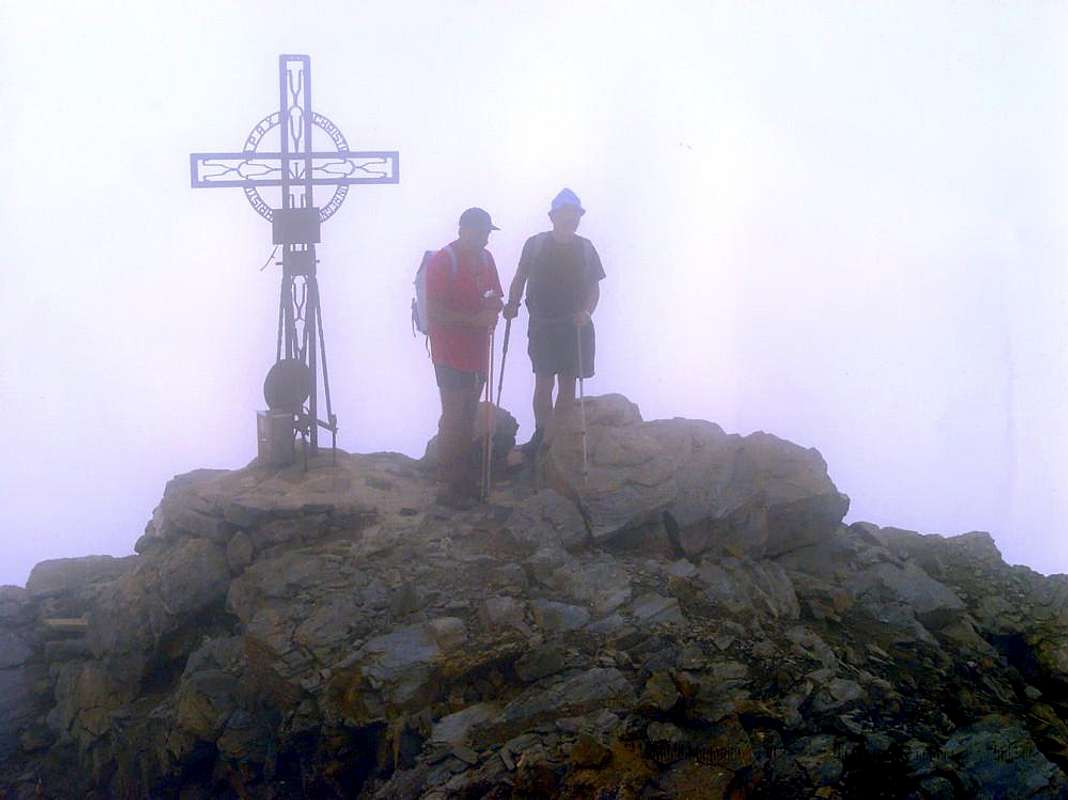-
 4324 Hits
4324 Hits
-
 77.48% Score
77.48% Score
-
 8 Votes
8 Votes
|
|
Fact Sheet |
|---|---|
|
|
Aosta |
ORIENTAL OVERVIEW
We arrived there where no one goes. After the Rosa of Banchi and Laris Hill or Larissa are the Columns of Hercules, ie the Unknown. Only locals and few fans, including the Fishermen for the richness of these lakes, they know this neglected area that stretches towards the Canavese, in Piedmont. Rather they are perhaps the most mountaineers "Eporediesi" (inhabitants by Ivrea Town & surrounding) that attend these vallons abandoned by God and men. There are lofty mountains and even famous. The Rosa dei Banchi (3164m) dominates them all. Yet they belong, such as the Gran Paradiso and Mount Blanc, in the Graian Alps. From Valley of Aosta side wild walloons rise, more and more difficult to follow moving Eastward. A place to "Briganti" (Brigands), a distant Far East. From what of Piedmont sweeping walloons and sunny valleys rise to the watershed overlooking the Valley of Aosta, with its great mountains that suddenly appear to those who joined him. Everything has remained intact and those who want to visit them must prepare for long and tiring trips, but still finding Naturalistic untouched paradises. Then they decline, softly more to the East towards the Town of Ivrea and the Po Plaine, leaving room for the Cottian Alps that rise up to the Monviso superbly. In this way "die" the Graians, or are born with the Sun in the Morning to go to decline Evening on Mount Blanc. There, everything changes and reverses back to the East route with the birth of the Pennine Alps. A circle of mountains that runs from the Ligurian Sea to the Julian Alps and the Adriatic Sea. The Imperial Crown of Italy Queen: But With Great Sorrow The Door Down (Maritime Cottian Graian Pennine Lepontine Rhaetian Julian Alps)...
^ ^ ^ "These Gentlemen know where they are: on top of the Eastern Graian ... ",
by p-mike
Siam arrivati là ove non va nessuno. Dopo la Rosa dei Banchi ed il Colle Larìs o Larissa ci son le Colonne di Ercole, cioé l'Ignoto. Sol gli abitanti del posto o pochi appassionati, tra i quali i Pescatori per la ricchezza di questi laghi, conoscon quest'area negletta allungantesi verso il Canavese, in Piemonte. Anzi son forse gli alpinisti eporediesi che maggiormente frequentano sti valloni abbandonati da Dio e dagli uomini. Non ci son montagne eccelse e neppur famose. La Rosa dei Banchi (3164 m) le domina tutte. Eppur fan parte, come il Gran Paradiso ed il Monte Bianco, dell'Alpi Graie. Dal versante valdostano salgon selvaggi valloni, sempre più difficili da percorrersi spostandosi verso Oriente. Un luogo da Briganti, un lontano Far Est. Da quello Piemontese estese valli e valloni assolati salgon allo spartiacque affacciandosi alla Valle di Aosta con le sue grandi montagne apparenti d'improvviso a chi vi ci arriva. Tutto é rimasto integro e chi vuol visitarli deve prepararsi a lunghe e faticose escursioni, trovando però ancora Paradisi Naturalistici incontaminati. Poi declinano, dolcemente, sempre più ad Est verso la Città di Ivrea e la Pianura Padana, lasciando spazio alle Alpi Cozie che superbamente si rialzano al Monviso. In questa maniera "muoion" l'Alpi Graie, oppure nascon insieme al sole del Mattino per andare declinar la Sera sul Monte Bianco. Lì tutto cambia e s'inverte di nuovo verso Oriente la rotta con la nascita dell'Alpi Pennine. Una cerchia di monti che corre dal Mar Ligure fino alle Giulie ed al Mar Adriatico. La Corona Imperiale d'Italia Regina: Ma Con Gran Pena Le ReCa Giù ...
"I'm not a Lady," and even a Rose , but an Old Glacier (= Roizà) now almost exhausted!
A Rose? No a very Ancient GlacierEverybody thinks I'm a Rose, a rose suspended on large rocky plates I skim the foots and on which I stand. But no. I'm just an old, very old glacier (Roizà) who has lost his pieces on the street and that, retiring, has brought to light these crushed rocks that touch the Sky. They are ugly and they are beautiful, because they reflect the flow of Life. Among my wrinkles Millennia have passed, even Millions of years and the Sun, merciless, burned them in competition with the Frost that has flogged to finally break them, my ancient glacier remained the tracks, suspended between the smooth rock slabs which has smooth sliding towards the Miserin Lake and the Valley of Champorcher. Who wants to climb them will face the path of Prehistory, the Mountain that precedes a long time that the little man ...
Rosa dei Banchi (3164m) Mountain Chain from Mount Glacier, with Western View,
by emilius
Tutti credon ch'io sia una Rosa, 'na rosa sospesa sulle banconate rocciose sfiorantemi i piedi e sulle quali m'appoggio. Invece no. Son soltanto un antico e vecchio ghiacciaio (Roizà) che ha perso i suoi pezzi per strada e che, ritirandosi, ha portato alla luce queste rocce frantumate che arrivano al Cielo. Son brutte e son belle, perché rispecchian lo scorrer della Vita. Tra le mie rughe sono trascorsi Millenni, anzi Milioni d'Anni ed il Sole, impietoso, le ha bruciate in concorrenza con il Gelo che le ha fustigate per infine spezzarle; del mio antico ghiacciaio son rimaste le tracce, sospese tra le lisce placche di roccia levigate scivolando verso il Lago Miserin e la Valle di Champorcher. Chi vuol salirle si troverà davanti il cammin della Preistoria, quella delle Montagne anticipante di molto quella del piccol uomo ...
Rosa dei Banchi (3164m) the long ridge from Peradzà Point,
by emilius
But when he returns Grandfather Winter I dress again with my dress white ermine. I lie down, like a royal gown, in all directions, the four cardinal points and send my cold breath of life out of Valleys and Ravines making them hope to return as soon as possible in the Spring.
"The Winter returns me the Ancient Youth ...",
by emilius
Però quando ritorna Nonno Inverno io mi vesto di nuovo con il mio vestito bianco ermellino. Lo distendo, come un abito regale, in tutte le direzioni dei quattro punti cardinali ed invio il mio freddo soffio vitale su valli e valloni facendo loro sperare al più presto nel ritorno della Primavera.
"But the Spring is still far away and I hide behind the hills",
by emilius
"This is the Mulère, you just Walloon wrong! / Questo é il Mulère, avete proprio sbagliato Vallone!",
by emilius
Point of Vorea: a big ridge hidden from the world. "Only Champorcher know ..."
Mysterious VòreaThe Point of Vòrea is not the Bec Mollère also Mulère. What is at the top of the Walloon of Vercoche, and secondary to that of the Legna, and one of Larìs or Larissa (even in the West) on the watershed addressed in the Northeast and towards the underlying Village of Outre l'Eve (1229m), and in the direction of Vigneroisa and beyond the Torrent Ayasse Verana, fractions of Champorcher. Another watershed falls, parallel and with the same direction, more to the East; originates from Mount Nero (2737m) on the border with Piedmont. After the Mount Santanel (2721m) and the Point Vercoche (2618m) above the Lake full of fish Chiletto also Chelett (2322m), forms the Point of Vòrea (2554m), and again after an additional collar, the jagged Ridge Vòrea of which culminates in a beautiful rocky Tower with the same name (2442m). On the opposite side falls instead the Vercoche Walloon, where at the top are "stuck" the three Lakes Molera, Piana (2246m) and Vercoche (2202m), this last is the largest and site at Fishermen Bivouac. On top of them dominates the Point Vòrea, while to the West lie the Bec Mollère (2638m) and Bec Laris (2426m). The junction between these two walloons partition starts just before the Alpages of Ourty (1527m), at the entrance of the "Walloon of the Legna". It is easy, if you are not local residents or fans Fishermen, do a bit of confusion and, in the fog or on days with clouds at low altitude, maybe even lost exchanging with one another. As happened to us back in 1987, at the end of Spring. Convinced to go to Mulère, were wrong walloon and found ourselves climbing a ridge we saw there in front (see photo) that culminated in a double Summits, where the highest was that I went up to the East steps with fun and also challenging, and while "The Camillo and The Franco" came up with my son Christian trying hard to find minerals, reached the Summit through to the next, a little lower. We went down to the simple but rugged South-outhwest Crest, up to a notch that preceded the typical "guns" rocky pointed threatening toward the sky. Reached an inviting collar went down to the East through an earthy groove in a small and narrow walloon, facing the Northeast over the Alps Perosa and St. Anthony New Homes (1931m), so we began to understand where we were, but what we had not yet risen. It took time and other tours in the best days and, without knowing or even intending to, we had covered a way probably ever made by anyone. But we did not know and was not the first time this has happened ...
"These Gentlemen do not even know where they are and what they want to do ... / Questi signori non san nemmen ove son e cosa voglion far...",
by Camillo Roberto Ferronato
La Punta di Vòrea non é il Bec Mollère o Mulère. Quello si trova al vertice tra il Vallone di Vercoche, secondario ed ad Ovest di quello della Legna, e quello di Larìs o Larissa (ancor più ad Occidente) sullo spartiacque rivolto a Nordest e verso il sottostante Villaggio di Outre l'Eve (1229 m), nonché in direzione di Vigneroisa ed , al di là del Torrent Ayasse, Verana, frazioni di Champorcher. Un altro spartiacque scende, parallelo e con la stessa direzione, più ad Est; s'origina dal Monte Nero (2737 m) al confine col Piemonte. Dopo il Mont Santanel (2721 m) e la Punta di Vercoche (2618 m), sopra il pescoso Lago Chiletto o Chelett (2322 m), forma la Punta di Vòrea (2554 m) e, nuovamente dopo ulteriore colletto, la frastagliata Cresta di Vòrea culminante in una bella Torre rocciosa con lo stesso toponimo (2442 m). Sul lato opposto discende invece il Vallone di Vercoche, dove nella parte alta son "incastrati" i tre Laghi di Molera, Piana (2246 m) e Vercoche (2202m); quest'ultimo risulta il maggiore ed é sito presso il Bivacco dei Pescatori. Al di sopra d'essi domina la Punta di Vòrea, mentre ad Ovest si collocano il Bec Mollère (2638 m) ed il Bec Larìs (2426 m). Il bivio divisorio tra questi due valloni trovasi appen prima dell'Alpe d'Ourty (1527 m), all'ingresso del "Vallone della Legna". Risulta facile, se non si è abitanti del posto oppure appassionati Pescatori, fare un pò confusione e, nella nebbia od in giornate con le nuvole a bassa quota, magari anche perdersi scambiandone uno con l'altro. Come successe a noi nel lontano 1987, al termine della Primavera. Convinti d'andar al Mulère, sbagliammo vallone e ci trovammo a salire un crestone lì davanti (vedi foto) culminante in una punta bifida, ove la più alta era quella ad Oriente. Lo salimmo con passaggi divertenti ed anche impegnativi e, mentre "Il Camillo ed Il Franco" salivano con mio figlio Christian cercando introvabili minerali, raggiunsi la Vetta attraversando alla successiva, d'un poco più bassa. Scendemmo per la facile, ma frastagliata Cresta Sud-sudovest, fino ad un intaglio precedente caratteristici "cannoni" rocciosi e minacciosamente puntati al cielo. Raggiunto un invitante colletto ne scendemmo ad Est tramite canalino terroso in angusto valloncello, rivolto a Nordest sopra l'Alpi di Perosa e Sant'Antonio Case Nuove (1931 m); così cominciammo capir dove fossimo, ma non ancor cos'avessimo combinato. Ci volle tempo ed altre escursioni in giornate migliori ed, ignari e senza neppur volerlo, avevam percorso una via probabilmente mai fatta da nessuno. Ma allora non lo sapevamo e non era la prima volta che ciò capitasse ...
Unknown Bec Mollère & Known Vòrea
"Beyond to the left Vòrea, here the Mulère, got it! / Di là a sistra la Vòrea, di qua il Mulère, capito!",
by emilius
"But are you sure that we are here to Mulère Pic? What Fog! ... / Ma sei sicuro che siam qui al Mulère? Che Nebbiun! ... ",
by emilius
Bec Mollère or Pic Mulère: "Are a small unknown Mountain: what do you want from me?"
Known Pic MulèreWhen I think of Bec or Pic Mollère or Mulère me is a sense of unease. I have gone a couple of times, but I never remember exactly where it is. In fact the first time I have wanted to climb it wrong mountain. The Camillo and the Franco said he knew the area well and we went to "hunt" of minerals. Blame the Fog? It may be, but instead of Bec Mollère we found ourselves on top of the Point Vòrea. Stuff happens. Even at Mount Paramont I went to climb the Punta Bianca and in the midst of the fog I found myself on top of the first. I realized the incident to forty meters from the Summit, where the ruins of a hospital brought me back to reality, because there was past down in 1969, after climbing the North Wall. Even things happen to the Living. So I went to see this Bec also Pic Mollère, standing there in the bottom of the Walloon of Laris and close to Monte Nero. We crossed and we are going to eat under the North Face of the latter, where it can be seen from another angle. Then we came back again. But every time I think of him it is very difficult to place. This is something very serious?
PINOCCHIO
"Com l'é Mister? Un gran Bourdell, a volte l'é di qua, altre di là e nemmen si può dir ch'abbiamo bevuto. Siam completamente astemi!
/
UNTRUTHFULS
How is Mister? A Large & Great Brothel, is sometimes here and there and even more you can say that we drank. We are completely abstemious & abstinent!... ",
by emilius
Quando penso al Bec o Pic Mollère oppur Mulère mi vien senso di disagio. L'ho salito un paio di volte, ma non mi ricordo mai esattamente dove sia. Anzi la prima volta che ho voluto andarvici abbiam sbagliato montagna. "Il Camillo ed Il Franco" dicevan che conoscevan bene la zona e siam andati a "caccia" di minerali. Colpa della Nebbia? Può esser, ma invece del Bec Mollère ci siam ritrovati in cima alla Punta di Vòrea. Cose che succedon. Anche al Mont Paramont ero andato per salir la Punta Bianca ed in mezzo alla Nebbia mi sono RItrovato in cima al primo. Mi son reso conto dell'accaduto a quaranta metri dalla Cima, dove un rudere di ricovero m'ha riportato alla realtà, perché lì ero passato nel 1969 in discesa, dopo aver scalato la Parete Nord. Ancor cose che succedono, ai Vivi. Così son andà veder sto Bec o Pic Mollère, che sta là in fondo al Vallone del Larìs e vicino al Monte Nero. Abbiamo traversato e siamo andaTI a maGNAR sotto la Nord di quest'ultimo, donde lo si vede da un'altra angolazione. Poi ci siam ancor tornati. Ma ogni volta che penso a lui mi vien difficile collocarlo. E' cosa molto grave?
"But are you sure that we are here to Mulère Pic? Do not worry, this is just seen him from the Hill of Eastern Larissa ... ",
by emilius
"Towards Graians Southeast: Bec delle Steje or Strie, Cima of Bonze, Chenessy Point and Crest, Fricòla Point, Mount of Corni, Vorèa Tower, Crest & Point, with Northwestern View",
by Osw
Ma voi siete mai stati a Pont-Bozet (775m)? Ogni qualvolta passavam con emilius lo guardavam dall'alto della strada proseguente per la Valle di Champorcher. Ed ogni volta arrivavam identica constatazione: ma come si fa a viver per tutto l'anno in un posto del genere. Incastonato tra le rocce d'una gola, ove si riuniscon l'acque del Torrent Ayasse con quelle del Rio Laborney eppoi, appen più in basso, col Torrent di Brenve, si aggrappa alle rocce sopra un Ponte Medioevale. Un posto da Lupi, anzi sicuramente abitato dal Diavolo che nasconde il Sole ai suoi abitanti per quasi tutto l'Inverno. Dall'altra parte od "Adrèt", sopra la testa pendon alti pareti rocciose del Mont Charvatton (1787 m), alte fino a 500 metri, dove la Fantasia vede Giganti pronti scagliar ciclopici macigni sovra i poveri sottostanti abitanti. Anche per i Romani, che qui passavano per salire in Champorcher, dev'esser stato un momento di paura superare questa "porta di ingresso". Se il buon giorno si vede dal mattino ... Ciononostante qui abitan da sempre, come testimoniano la chiesa parrocchiale del 1500, la Chiesetta del Gond, monumento nazionale dello stesso periodo, la grossa volta feudale prima dell'abitato ed i due ponti Medioevali sull'Ayasse, il tutto storicamente confermato dai sigilli dei Savoia conservati nell'Archivio del Municipio. Gente robusta di stampo antico, abituata a convivere con l'asprezza della vita di montagna, per la quale le nostre impressioni posson parir ridicole e da Turistucoli. A conferma di ciò, l'Abate Pierre Chanoux lo riteneva "un verde sogno di pace"; infatti dall'altra parte od "Envers", s'estendono i vasti e selvaggi Valloni di Brenve e Manda o, in tempi più remoti, Amanda. Se volete andar alla Punta di Chenessy, partendo da Pont Bozet, dovete prendere quest'ultimo e, lasciando ad Oriente il bivio per il Villaggio di Crest
* Orrido del RATUS, dove sembra venivano precipitati i nemici e Santuario di Re Tempio a 1470 metri, dove un antico e pre-cristiano altare in pietra suggerisce di sacrifici umani. Come per i Maya e gli Atzechi, tanti templi tanti peccatori, come per quel libro Americano "Grandi Cattedrali Grandi Peccatori". In fondo a questo Mondo non é mai cambiato nulla.
proseguendo verso Mezzogiorno con la mulattiera che, attraverso splendidi boschi di pini, larici ed abeti, raggiunge i cinque laghi ad Est della Cresta di Chenessy e l'omonimo lago (2383 m), alla base della Faccia Est della punta di Chenessy donde, salendo a Nordovest, ci si ricongiunge alla via che sale, attraversata la cresta spartiacque, dal Vallone della Legna.
"Towards Graians Southeast: Chenessy, Vòrea and Mulère? Do not worry, thence to South, with North-northwestern View / Chenessy, Vòrea e Mulère? Tranquilli, di là a Sud ...",
by emilius
Retrieved from "Guide to the Western Alps - Vol II. Graians and Pennine" by Giovanni and Luigi Bobba Vaccarone, May 25, 1896; Edit. Turin Section of C.A.I., page 26.
Costa of Canessi m. 2631. This is the climax (trigonometric signal) of the chain attached between the walloons of the Legna and Amanda, an easy slope up from the west side, to its North lies the Cape of M. Digny - m. 2145 - to the North of which passes a path that puts in direct communication Amanda the upper basin , rich in the five lakes, with Champorcher.
"Climbing to Points of Chenessy",
by emilius
Estratto dalla "Guida delle Alpi Occidentali - Vol. II. Graie e Pennine" di Giovanni Bobba e Luigi Vaccarone, 25 Maggio 1896; Edit. Sezione di Torino del C.A.I., pagina 26.
Costa di Canessi m. 2631. E' il punto culminante (segnale trigonometrico) della catena divisoria fra i valloni della Legna e della Amanda; un facile pendio vi sale dal versante ovest; al suo nord trovasi il promontorio del M. Digny - m. 2145 - a nord del quale passa un sentiero che mette in diretta comunicazione il bacino superiore dell'Amanda , ricco di cinque laghi, con Champorcher.
"Chenessy Summit, with Northern View to Mount of Corni",
by emilius
A Domain above Pont Bozet, a Hamlet hidden by the Devil, where there is never the Sun
Chenessy also Canessi Points But you 've never been to Pont- Bozet (775m )? Whenever passing with Emilius watched him from the top of road that continues in the Valley Champorcher. And every time arriving the identical observation: but how do you live year-round in a place like this. Nestled between the rocks of a gorge, where they meet the waters of Torrent Ayasse with those of Rio Laborney and then, just lower, with the Torrent of Brenve, clings to the rocks above a Medieval Bridge. A place to Wolves, indeed certainly inhabited by the Devil that hides the Sun to its inhabitants for most of the Winter. On the other side, or "Adrèt" over your head hang down the high cliffs of the Mount Charvatton (1787m), rising up to 500 meters, where the Fantasy sees Giants ready to hurl gigantic boulders above the poor underlying population. Even the Romans, who spent going up to Champorcher, must have been a moment of fear overcome this "entrance door". If a good day starts in the morning ... Nevertheless always lived here, as evidenced by the parish church of 1500, the little Church of Gond, a national monument in the same period, the big feudal time before the town and the two Medieval Bridges up th'Ayasse, all historically confirmed by the seals of the Savoy kept in the Municipality. People sturdy old-fashioned, accustomed to living with the harshness of mountain life, for which our impressions may appear ridiculous and naive Tourists. To confirm this , the Abbot Pierre Chanoux thought it "a green dream of peace"; for this reason the other side or "Envers", extending the vast and savage Walloons of Brenve and Manda also, in more remote times, Amanda. If you want to go to the Chenessy Point, starting from Pont Bozet Hamlet, you have to take this last and leaving at the alternative to the East Village Crest * Ravine of the RATUS, where it seems precipitates were the enemies of the King Temple and Shrine at 1470 meters, where an ancient, pre- Christian stone altar suggests that human sacrifices. As for the Mayans and the Aztecs, many temples many sinners, as that book American "Great Cathedrals Great Sinners". In the end of this World has never changed anything. continuing towards the South with the mule track through beautiful forests with pines, larchs and firs, reaches five lakes east of the Crest of Chenessy and the eponymous lake (2383m) at the base of the East Face of the Point of Chenessy going to and from this it joins the Northwest the via that goes up, crossed the dividing ridge, from the Valley of Legna.From Western Antesummit Mount of Corni (2754m) descends parallel to the two preceding a dividing ridge between the Legna Walloon (West) and that of Manda, this last with beautiful Lakes Cornuto (2450m ; Bivouac of Forestry) and Chenessy (2383m; perfectly square shape of the base of the East Slope of the Point Chenessy), this partition form Fricolla Pass to the North (2542m) and immediately after the eponymous peak (2676m). Beyond the ridge unfolds a series of altitude quotas calls Chenessy Ridge (2665m, the highest) which ends with the Point Chenessy (2630m), the most well known and visited, although not the highest of the ridge itself. More to the North buttress is marked by two collars, the Manda and Detrà (about 2380, 2365 metres) separated from each other by Quota 2414 meters above the rugged and round Mount Giavin (2431m). Further and more in Northeast Mount Digny (2145m) and the Crest of Lut(t)a with Plan Merlé (1646m) and the Cross of Gual constitute the final of the watershed, above the Villages Frassiney and Trembesere. The Collars above offer the possibility of passing from one to another walloon, but are formed by steep grassy slopes for which I scarcely advisable; should lengthen the course to the North to reach the Mount Giavin, from which a good path descends to hillside to the lakes and the Walloon of the aforementioned Manda. But for those who want to climb the Point Chenessy from the Walloon of Legna, after reaching from St. Anthony Pastures to Creton Alp (1896m), can be useful to the first of the two, that is, of Manda; reached the same it is better to go through with a short descent below the steep ridge North-northeast and make the ascent on the East Face via a steep grassy slope with easy rocks, below a series of large slabs compact and smooth. In the last part we reach the ridge above which easily leads to the Summit, from where you can admire the Mount Marzo (2756 m; most famous) and the Mount of the Corni (2799m), highest peak from the Rosa of Banchi at the end of Graians to Valchiusella, small valley secondary compared to that of Orco-Locana-Soana-Ceresole Valley in Piedmont.
"Giavin & Chenessy Summits, with Northwestern View from Dondena Royal Road",
by emilius
Dall'Antecima Ovest del Monte dei Corni (2754 m) scende parallela alle due prededenti una cresta spartiacque tra il Vallone della Legna (Ovest) e quello della Manda, quest'ultimo coi bei Laghi Cornuto (2450 m; Bivacco della Forestale) e di Chenessy (2383 m; di forma perfettamente quadra alla base del Versante Est della Punta di Chenessy); questo divisorio forma verso Settentrione il Colle della Fricolla (2542 m) e subito dopo l'omonima punta (2676 m). Oltre la cresta dispiega una serie di quote complessivamente chiamate Cresta di Chenessy (2665 m, la più elevata) terminante con la Punta di Chenessy (2630 m), la più conosciuta e frequentata, anche se non la più alta della cresta medesima. Maggiormente a Nord il contrafforte é segnato da due colletti, della Manda e Detrà (2380, 2365 metri circa) separati tra di loro dalla Quota 2414 metri e precedenti il robusto e tondeggiante Mont Giavin (2431 m). Più in là e più a Nordest il Mont Digny (2145 m) e la Cresta di Lut(t)a con Pian Merlé (1646 m) e la Croce di Gual costituiscono il termine ultimo dello spartiacque, sopra i Villaggi di Frassiney e Trembesere. I Colli di cui sopra offrono la possibilità di passaggio dall'uno all'altro vallone, ma son formati da ripidi pendii erbosi per la qual cosa scarsamente consigliabili; conviene allungare il percorso a Nord raggiungendo il Mont Giavin, dal quale un buon sentiero scende a mezzacosta verso i laghi predetti ed il Vallone della Manda. Ma per chi vuol salire la Punta di Chenessy dal Vallone della Legna, dopo aver raggiunto dagli Alpeggi di Sant'Antonio il Creton (1896 m), può essere utile il primo dei due, cioè della Manda; raggiunto il medesimo, é meglio attraversare con una breve discesa al di sotto della ripida Cresta Nord-nordest ed effettuare la salita sul Versante Est tramite un ripido pendio erboso con facili rocce, sottostante una serie di grandi lastronate compatte e levigate. Nell'ultimo tratto si raggiunge la cresta suddetta facilmente conducente alla Sommità, dalla quale si ammirano il Monte Marzo (2756 m; più famoso) ed il Monte dei Corni (2799 m), cima più elevata dalla Rosa dei Banchi al termine delle Alpi Graie insino alla Valchiusella, piccola valle piemontese secondaria rispetto a quella di Orco-Locana-Soana-Ceresole.
This is the Top of the Battle: Leonidas fought here, Hannibal, the Partisans and Martin Luther King, Obama's wait ...
Battle for THE LibertyBut what Battle has been carried out in the vicinity of this top? We do not know and no one says. Even Bobba and Vaccarone in their "Guide to the Western Alps", of 1896. And then it is really arduous & difficult thing to find out. Even Mario Aldrovandi in his "Guide of the Aosta Valley", 1930/32. A battle between the Romans and the ancient Salassians? Uhhh, difficult! Among the Phalanges Acheas by Leonidas and the Persians? No, this never came. Hannibal passing the Alps with Elephants? Not even. Between Austrian and Napoleonic troops. Neither, Napoleon, after the Fortress of Bard, thought only to expand its Army in the Italian Campaign. A joke to hunt bison with Buffalo Bill? Not at all, because these parts are just cows. The Partisans in World War II against the Nazis? The Red Army or the Red Mao Tse Tung? Ever seen a Chinese, in those times, these parts Khrushchev and Kennedy was too busy with other small and insignificant chores. Nor is it ever Marthin Luther King to act as a mediator, as well as Ghandi, the Pope and even Obama. And then how to get to the Historical Truth of this "Historic Battle", so important to give the name of a Mountain?
It can be. Easier to a clash between the inhabitants of the pastures nearby valleys. As in Valpelline, where there is a Plan of the Battle and the Arête a Bonnemort (Ridge of the Good, ie Right, Death) due to the clashes between farms "Valpelleneins" and the inhabitants of the Valais, which passed the border in search of new pastures for livestock.
"Ma dove si trova sta Cima della Battaglia? Giù per là vers'al Piemùnt ... / But where is this Top of Battle? Thence down to the Piedmont ... ",
by emilius
Ma qual Battaglia s'é svolta nei pressi di questa cima? Non lo sappiam e nessun lo dice. Neppur Bobba e Vaccarone nella loro "Guida delle Alpi Occidentali", del 1896. Ed allora é veramente cosa ardua e dura il scoprirlo. Neppur Mario Aldrovandi nella sua "Guida della Valle di Aosta", 1930/32. Una battaglia tra Romani e gli antichi Salassi? Uhhh, difficile! Tra le Achee Falangi di Leonidas e l'Armata di Persia? No, qui non risultan esser mai giunte. Annibale attraversando le Alpi cogli Elefanti? Neppure. Tra truppe Austriache e Napoleoniche. No, Napoleone, superata la Fortezza di Bard, pensava solo ad espander il suo Esercito nella Campagna d'Italia. Una battuta di caccia al bisonte di Bufalo Bill? Niente affatto, da queste parti trovi solo mucche. I Partigiani nella Seconda Guerra Mondiale contro i Nazisti? Può essere. L'Armata Rossa od i Rossi di Mao Tse Tung? Mai visto un Cinese, in quei tempi, da queste parti e Kruscev era troppo impegnato con Kennedy in altre faccenduole. Neppur s'é mai visto Marthin Luther King a far da mediatore, così come Ghandi, il Papa ed anche Obama. Ed allora come arrivar alla Verità Storica su questa Memorabile Battaglia, sì importante da dar nome ad una Montagna?
Più facile uno scontro per i pascoli tra gli abitanti delle valli vicine. Come in Valpelline, ove esiste un Piano della Battaglia ed una Arête de la Bonnemort (Cresta della Buona, cioé Giusta, Morte) causa gli scontri per i poderi tra i "Valpelleneins" e gli abitanti del Vallese, transitanti il confine alla ricerca di nuovi pascoli per il bestiame.
"Arriving ThunderStorm on Rosa dei Banchi Northern Ridge",
by emilius
Neat Spot Reply
Voted 9/10
What a nice spot to look out over these mountains.
Re: Neat Spot Reply | Edit | Delete
Hasn't voted
Yes, but not when it comes the lightning Storm. Better to stay down at the Bar
HELLO & THANKS
osw
"Meglio darsi 'na mossa che qui arriva l'Inferno! / Better hurry because here comes the Hell!",
by emilius
A HELLO to ALL from the Graian Alps of the Southeast!
CIAO-HI to ALL & to HELL!Dear Boys we joked and had fun, but now it is better to sneak away quickly run for it, because it begins to get a Big Thunderstorm and already the Rocks fry!
"Let's go to Summit, but then we run like Devil! / Svelti in Cima, prima che venga fuori il Signor Diavolo! ",
by emilius
Cari Ragazzi abbiam scherzato e ci siam divertiti, ma adesso é meglio tagliar la corda, velocemente ed a gambe levate! Perché qua comincia ad arrivar Gran Temporale e già friggon le Rocce!
"Defying the Lightning, can say that we arrived at the Peak! Hopefully we will not go to sink to the bottom!!! / Dal Picco! Non é che finiam colar a picco!!!",
by emilius
"This Little Devil that flashes me behind my back I do not like at all ... / Sto Diavùlett lampeggiant andria non me piàs per gnènt ...",
by emilius


